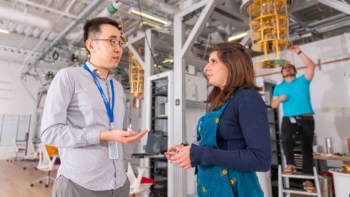
The smallest quantum computer to date has been claimed by a team of researchers in Austria, Switzerland, and Germany. Using strings of trapped ions that are addressed using laser pulses, Ivan Pogorelov at the University of Innsbruck and colleagues created a system that contains 24 fully-entangled quantum bits (qubits) and is housed in two industry-standard server racks.
The teams says that the computer’s performance matches that of existing state-of-the-art systems and believe that their setup could bring the widespread use of practical quantum computers a step closer to reality.
As technology improves, quantum computers are integrating increasing numbers of qubits with the goal of creating devices that can solve certain problems much faster than conventional computers. Existing ways of integrating qubits often require a room full of equipment so researchers have now turned their attention to developing much more compact and practical implementations. These efforts face numerous challenges, however, including how to reliably manufacture large numbers of identical qubits and how to maintain the quantum coherence of qubits during complex operations such as the quantum entanglement of ions.
Calcium ions
Pogorelov and colleagues tackled these challenges in a system that uses entangled calcium ions as qubits. The ions are held in place within a Paul trap, which confines charged particles using dynamic electric fields. Within the trap, the entanglement of up to 50 ions can be achieved through interactions with laser pulses, which are also used to read out and write quantum information onto individual ions.

New gate optimization strategy could boost efficiency in trapped-ion quantum computers
The team’s setup was compact enough to be implemented within several modules that occupy two industry-standard server racks. Contained within aluminium boxes, the stackable modules include all the electrical components needed to generate and control the laser light and all necessary components for communication and remote control.
As an initial demonstration, the team used the setup to create a Greenberger-Horne-Zeilinger state that contained up to 24 fully entangled qubits. During this operation, the ions retained their quantum information without any need for error mitigation techniques – matching the performance of much larger state-of-the-art implementations.
The team says that the modular system has high mechanical stability, easily replaceable parts, and minimal requirements for system maintenance. They say that the system can be operated by trained non-specialists and that it could also be used by people worldwide via cloud-based quantum computing. Pogorelov and colleagues are now making further improvements to their system with the aim of achieving the full entanglement of all 50 qubits trapped within the ion string.
The system is described in PRX Quantum.



